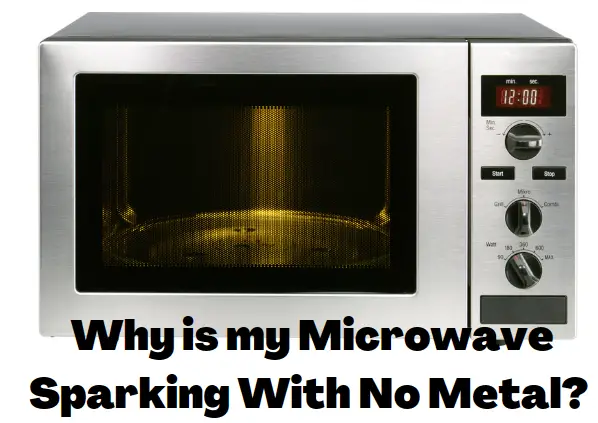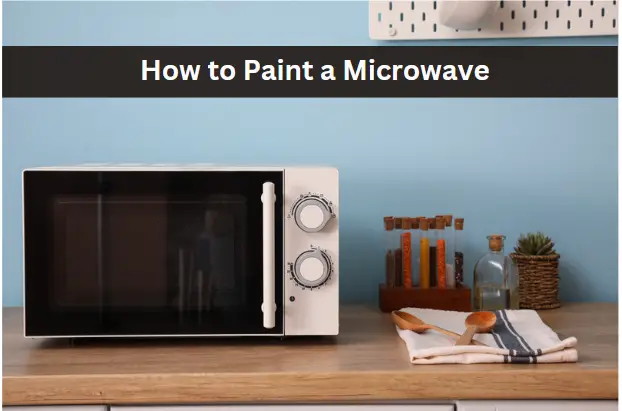Why is my Microwave Sparking Without Metal? Don’t Replace it Yet
Why is my microwave sparking without metal? This is an issue I had with my microwave a few weeks ago. There was no metal in sight, yet it was sparking when I heated my food.
This is a common issue that can be caused by several reasons! Unfortunately I had to get a new one due to faulty wiring, but that is not always the case.
Below I’ll outline some possible reason your microwave could be sparking, even though there is no metal in it and what you can do about it!

3 Signs Your Microwave Has Gone Bad
Are you having trouble with your microwave? If so, you’re not alone. Microwaves are one of the most commonly used appliances in the home, and they can easily break down over time. Here are 3 signs that your microwave has gone bad and how to fix them.
- Unusual Noises – If your microwave is making strange noises, such as buzzing or humming, it could be a sign that something is wrong. This could be caused by a faulty fan motor or an issue with the magnetron tube. To fix this problem, you should contact a professional appliance repair technician who can diagnose and repair the issue.
- Sparks Inside – If you notice sparks inside your microwave when it’s running, this could indicate an electrical issue such as a short circuit or loose wiring. You should never attempt to repair any electrical issues yourself; instead, call an experienced technician to inspect and repair the problem safely and correctly.
- Poor Performance – If your microwave isn’t heating food properly or takes longer than usual to cook food, this could be a sign that something is wrong with the internal components of the appliance. In this case, it’s best to contact an appliance repair technician who can diagnose and repair the issue quickly and efficiently.
Why is My Microwave Sparking With No Metal?
If your microwave is sparking without any metal inside it, don’t panic! There are a few steps you can take to fix the issue.
Check the Waveguide Cover
A waveguide in a microwave is a panel on the thicker side of the microwave. It contains a hollow metal tube that helps direct the heated electromagnetic waves to properly cook food. It is typically found inside the oven and is covered with a mica sheet or other material to prevent steam and food particles from interacting with the waveguide. The cover also helps to ensure that the microwaves are evenly distributed throughout the oven, so that food cooks evenly.
Replacing a waveguide cover can be done easily at home with some basic tools. First, you will need to remove the old cover by unscrewing it from the oven’s interior walls. Then, measure and cut a new mica sheet or other material to fit over the waveguide. Finally, secure it in place using screws or other fasteners.
Check Again for Metal Objects
Even if you think there is no metal inside, it’s still possible that something got in there accidentally. Carefully inspect the interior of your microwave for any metal objects and remove them if found.
If a metal object such as a lid or fork gets stuck in the interior of your microwave, it can cause sparks to occur. This happens because microwaves generate electromagnetic radiation which acts like a magnet, resulting in an electric arc that travels from the metal to grounded components inside the oven and causing sparks.
It is important to thoroughly inspect the interior of your microwave for any metal objects before turning it on. If you do find something stuck inside, try to remove it with tongs or a vacuum cleaner with a crevice attachment. If this isn’t possible, then it’s best to contact a professional technician for help.
Check the Rack Support
The microwave rack support is an optional part of the appliance. It helps to hold up the shelves and trays inside your microwave, ensuring that they are securely in place while you cook. It allows you to cook multiple dishes at once. They can be made of a microwave safe metal or plastic.
If your microwave has a rack support, it may be causing the microwave to spark if it is worn out or broken. The metal rack can conduct electricity and cause sparks when it comes into contact with other metal objects inside the microwave. This is especially true if the waveguide cover, which protects the microwave, is dirty or damaged.
Worn Microwave Stirrer
A microwave stirrer is a rotating device inside the top of the oven which helps to distribute heat evenly throughout the food by magnetically stirring it. The stirrer works by rotating at high speed, ensuring that any hotspots are eliminated and that the temperature throughout the item being cooked is consistent. This helps to ensure even cooking and avoids any burning or under-cooked spots in your food.
If a microwave stirrer is damaged, it can cause sparking inside the oven. This is usually due to the cover over the magnatron (the thing that produces the electromagnetic waves) being aged, burned or otherwise damaged.
5 Steps to Take if Your Microwave is Sparking With No Metal Inside
If you’ve noticed your microwave sparking with no metal inside, it can be a cause for concern. But don’t panic! Here are 6 steps to take if your microwave is sparking with no metal inside.
- Check the interior of the microwave for any signs of damage or chipped paint. If the paint is chipped, the interior metal will be exposed, causing the microwave to spark or arc.
- Make sure there are no items that contain metal in the microwave such as aluminum foil or a spoon. Even the smallest piece of metal inside your microwave will create sparks.
- Inspect the waveguide cover for any signs of damage or brittleness. This cover is a metallic sheet fitted on the inside, and if it’s damaged it can cause arcing and sparking in your appliance.
- Check all components of your appliance for any signs of wear and tear such as loose wires or faulty parts that may need replacing.
- Make sure that all vents are clear and unobstructed by food particles or other debris which could lead to overheating and sparking in your appliance.
Disclaimer: It’s always best to consult a trained technician to replace any parts necessary.
Can You Use a Microwave After it Has Sparked?
Using a microwave that is sparking is not safe and should be avoided. Sparks in a microwave oven can be caused by metal objects being placed inside the oven, or due to a malfunctioning door seal. Sparks can cause damage to the interior of the oven, as well as potentially causing a fire. It’s important to unplug your microwave immediately if it begins sparking, and contact an appliance repair service for further assistance.
Why is My Microwave Arcing?
Have you ever noticed sparks coming from your microwave while it’s running? This phenomenon is known as arcing, and it can be caused by a variety of things. Arcing occurs when electromagnetic waves emitted from the magnetron during cooking strike a metallic object inside the oven. Common causes of arcing include metal forks, tin foil, chipped paint on the interior walls of the oven, and food particles stuck to the waveguide cover.
If your microwave is arcing, it doesn’t necessarily mean that it needs to be replaced. If you identify and remove any metallic objects or food particles that may be causing the arcing, then you should be able to continue using your microwave safely. However, if you’re still experiencing arcing after removing any potential causes, then it may be time to get a new appliance.
Can a Faulty Microwave Cause a Fire?
Yes, a damaged microwave can be a potential fire hazard. Damaged wiring, loose connections, and faulty components can all cause the internal temperature of the oven to increase dramatically which could lead to an ignition. Additionally, arcing, which is caused by metal objects inside the oven or a malfunctioning door seal, can cause sparks that may lead to a fire. It’s important to immediately unplug your microwave if you notice sparking or other signs of damage and contact an appliance repair service for further assistance.
It’s also important to regularly check your microwave for signs of wear and tear like loose seals on the door. If you detect any issues with your appliance it’s best to take direct action as soon as possible in order to help minimize the risk of a fire occurring.
Final Thoughts



